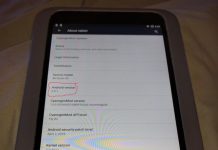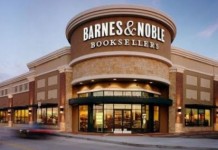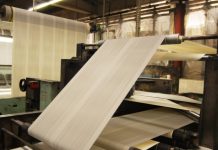 David Peck, co-founder of the Mischief & Mayhem Books publishing collective, had an interesting piece in yesterday’s The Daily suggesting that the end of big chain bookstores may be nigh and deservedly so.
David Peck, co-founder of the Mischief & Mayhem Books publishing collective, had an interesting piece in yesterday’s The Daily suggesting that the end of big chain bookstores may be nigh and deservedly so.
His argument is based in the economics of bookstores and distributors, in which the retail and middleman companies take most of the slices out of the retail price pie, leaving the publisher with a small sliver to pay its own expenses (including compensating the author). Even the wholesale price of the books isn’t necessarily fixed, as publishers have the clout to pass their own discounts on book prices on to the publisher. He also touches on the consignment system, which means bookstores can pass unsold content back to publishers for a refund at the publisher’s expense.
But a book isn’t like clothes: You don’t need to try it on to decide if you want to buy. The Internet has made it simple for readers to buy directly from publishers, without a retailer inserting itself – with its massive cuts and homogenizing aesthetic – into the mix. What’s more, improvements in print-on-demand technology mean that it’s no longer necessary to manufacture 10,000 books in the hope of selling half of them: A book need only be printed when someone buys it.
If publishers started selling print-on-demand (and, presumably, e-) books direct to customers, Peck suggests, it could drive mega-retailers like Amazon and Wal-Mart out of the book business, and more book-centric stores like Barnes & Noble out of business altogether. And it might not be such a bad thing—after all, nobody noticed when the record chain stores closed, because all the music they could ever want was available online. Just as small record stores that catered to a select crowd of customers survived, so would small bookstores.
I can certainly see some merit in Peck’s arguments. Certainly Baen has proved that a publisher can make a go of selling e-books direct to consumers. What if it were to add print-on-demand operations as well? They could replace mass-market paperbacks, since the quality still isn’t quite up to par with hardcovers. The question is whether Baen, or other publishers like them, could implement POD economically. For readers who chose to purchase that route—and Baen has a lot of loyal readers by now—it could mean lower prices, plus Baen saving money by avoiding the waste of large print runs.
But I suspect that any such innovation is at least a few years in the future. The publishing industry is a big, unwieldy beast, bad at changing directions in a hurry. Most publishers, Baen included, probably will not want to risk damaging their relationships with the big chain stores that they still believe they need to sell paper books. Indeed, many see publishers’ pricing practices toward e-books over the last ten years as a desperate attempt to hold them back in order to keep the chain stores alive!
It’s a sort of reverse chicken-or-the-egg situation—it’s not likely publishers will make moves to bypass big chain bookstores until and unless the big chain bookstores go under on their own, and indeed they’re going to try everything they can to keep that from happening. Certainly the music biz’s support for iTunes became a lot more whole-hearted after the big music chains collapsed.
But with Borders on the ropes already, and Barnes & Noble on its way there, perhaps this outcome is not as far away as we might think. If the Espresso book machine can get distributed in the hundreds or thousands rather than the dozens, perhaps big publishers will have more incentive to make their books available that way.
(As an aside, the way The Daily presents its articles for web viewing is really rather annoying: the same preformatted image as is used for the iPad version. Yes, very easy to read and all that, but it doesn’t make fair use any easier—I had to type the block quote in myself.)

































Publishers are themselves middlemen in case they haven’t noticed. A true no middleman market would be straight from writer to reader. One can see the slogan already. Writers of the World, Unite. You have nothing to lose but your publishers!
Joking aside if publishers think Amazon or B&N will calmly accept such a strategy then they are delusional. Both are more likely to swallow publishers as the other way around.
In case you think that is unlikely Amazon is already a publisher of note and so is B&N – Sterling Publishers is owned by them.
When I launched BooksForABuck.com, I initially took the ‘direct to consumer’ route. The margins are better but distributors offer a convenient one-stop-shopping venue that many consumers enjoy. My total sales (and net revenue) increased when I moved primarily to distribution.
As for POD replacing standard publishing, this might be possible for trade paperback. For mass market, POD costs are still too high.
Agree with gous that publishers would have a hard time taking on Amazon or B&N. Naturally I disagree with the statement that publishers are ‘middlemen,’ at least in the sense of not adding value. I believe that publishers add considerable value to authors and to readers (in editorial services, branding, selection, packaging, promotion, and design among other things).
Rob Preece
Publisher
Excellent article Chris.
I wouldn’t plan on ‘lower prices’. Look at how publishers have behaved with eBooks. They will price as high as they can get away with and those readers who are emotionally tied to paper will expect to pay for that attachment.
And considering that paper books in general will rise in price as print runs reduce, the future of paper will inevitably be expensive.
POD is the future, I have no doubt.
I’ll soon be in my 11th year publishing via print-on-demand (POD), so Dale Peck’s remarks strike me as more than a little clueless. He thinks POD will eliminate the need for distributors. In actual fact, one of the biggest pluses of doing POD via Lightning Source (ask any small publisher) is the fact that it gives you a very convenient backdoor into Ingram and a wealth of other book distributors here and in Europe. The 10% slice that Ingram takes is more than justified by the fact that, as a small publisher, I don’t have to worry with order-taking, credit-card verification, order processing, shipping, etc. All I need do is create books, upload their files to Lightning, and cash the checks each month. For most publishers, focusing what Peck call’s direct-to-consumer sales would be an enormous nuisance. I might as well start selling bananas and fixing washing machines.
His claim that POD is bad news for Amazon must come as a surprise to Amazon execs. Amazon has its own POD branch as well as close ties to Lightning Source for the latter’s many titles. POD’s ability to supply millions of books from a small or no physical inventory fits Amazon’s business model to near perfection and few publishers can match Amazon’s visibility or economy of scale. The fact that I’m a strong critic of some things that Amazon does, doesn’t mean that I don’t see them as a major part of my business model.
Finally, there is equipment that can do POD on location rather than in huge production plants. Unfortunately, the machinery makes little sense for a mom-and-pop bookstore. It costs too much. But it makes good sense for B&N superstore. In addition to the 200,000 titles in house, B&N could use in-house POD to print any of millions of titles within perhaps 15 minutes. They could even use their WiFi or computers to let people preview a book digitally before they buy.
Finally, POD is actually good for publishers, since it eliminates the cost and hassles of book inventories and returns. But there’s little or no need for publishers to see it for more than it is. In most cases, it doesn’t provide a good reason to get into selling and shipping books, except perhaps as a sideline for regular customers who want dozens of copies drop-shipped directly from Lightning to them.
This is a message I keep repeating. The book industry doesn’t need for any of the participants to become the entire market: not authors, not publishers, not distributors, not retailers, and certainly not Amazon or Apple. The relative size and role of each may change with new technologies, but they’re all needed.
–Michael W. Perry, editor at Inkling Books
POD of backist and mid-list titles may or not be a viable business model but mainstream publishers–specifically the big glass tower multinational–are the last people who could possibly figure out how to make it work for the simple reason that direct consumer sales require marketing and market research and the BPHs long ago outsourced those functions to retailers and divested themselves of all the in-house corporate knowledge in that area. Just as they outsourced content acquisition to literary agents.
The only core compentency at the BPHs these days are in deal-making, tax law, and number-crunching. Hardly the kind of staff needed to build up, from scratch, any kind of consumer-focused retail operation.
By the time they can possibly ramp up as viable competitors whatever “success” they achieve will be too little, too late. For such an approach to succeed it needed to be implemented last decade, not next.
Mid-sized and genre publishers, on the other hand, could make a go of it but those are the very outfits aggressively moving into ebooks so direct sales via POD isn’t likely to buy them anything worth the investment.
A couple years ago, POD *might* have saved the superstore chains by providing a deep catalog at minimal overhead .
Even now, if they were willing/able to ditch their palatial white elephant storefronts and could migrate to a B.Dalton-sized mall store format POD might be useful in providing near instant gratification for shoppers; buy online and pick-up at the store.
But from what I hear most chains are “chained” to their dinosaurian digs for the next decade, short of bankruptcy, and anyway, they lack the cash to rebuild with the still-pricy POD systems currently available.
POD is no silver bullet. It might work for some but unless the tech improves overnight it won’t arrive soon enough to be more than a footnote in the history of the book industry.
The big unaddressed issue is, let’s face it, that POD books are just ebooks DRM’ed in dead tree pulp. With the massless ebooks getting ever more mainstreamed the day of POD may have come and gone. Whatever market remains for print books in future decades will most likely be focused on books as collectibles so POD volumes will need to match or exceed the quality of current batch-printed premium hardcovers.
Who knows, maybe hand-crafted volumes may make a comeback.
Some may even come wrapped in “rich corinthian leather”. 😉
I’ve been lobbying for a vision much more like Felix’s above:
Chains may survive, but I think most of the “big box stores” will go away. Instead, we will likely see a return to the smaller Waldenbooks/B. Dalton retail store. About half of the retail space will be cafe, with a smattering of popular books on the shelves (4-5,000 titles maybe?)
Every visitor, if they don’t have a “browser device” will be able to rent a browser (Ipad/Kindle/android thing) for browsing for books while in the store.
See something you like? Order it and the employees in the back make a copy of the book POD in a few minutes for you to bring home.
Why would this work? Amazon beats retail stores on price and selection…the only thing it can’t offer is immediate delivery of physical books.
By having POD machines in every retail outlet (and working out arrangements with publishers — there’s the hitch), every book store can advertise “Every book ever published…in your hands in minutes.” Customers will pay the higher price to get the physical copy immediately. (or the bookstores take a cut of any ebook purchases made while the customer is add the cafe.)
It’s good for publishers — they slash printing, warehousing, shipping and returns costs.
Retailers can offer a vastly increased selection with much smaller square footage…and maintain healthy profit margins on POD books.
And readers get to buy any book ever published and have it in their hands in minutes.
I really think this could work. (and could be translated to “mini-Waldenbooks” in McDonalds/Starbucks in smaller towns that can’t support a traditional bookstore).
Bill Smith
http://www.BillSmithBooks.com
Talking of ‘hand-crafted volumes’, ie personalisation of POD, there might be a market for covers and artwork printing, with content (text) read on an ereader.
This lets people collect book covers/packages, luxury items, to handle and display in their homes, and still have immediate access to content anywhere anytime, ie, from the cloud.
Whilst Amazon and Walmart can continue offer such big discounts off the RRP, I think the have nothing to fear from direct sales from the publisher’s website.
I can’t see a publisher offering the same discounts.
I have to say that though I respect his experience, I am totally confused by Michael W. Perry’s post.
I would have thought that there is a broad consensus that paper books will reduce in sales at a steady rate over the next 15 years. I personally agree with people who say that the widespread emotional attachment to paper will give them a long tail. It would therefore appear logical that the print runs of the big sellers will be reduced over that term, and the print runs of middle order books will suffer even more. The print run of low sales books will become increasingly uncommercial.
The first corollary of that scenario, if true, is surely that paper book prices will have to increase in price if distributors and book shops are to stay in business to serve the remaining demand for paper books. After all lower sales in the shop means higher prices to stay in business and smaller print runs means higher wholesale prices to repay publishers for their work.
The second corollary of that scenario, if true, is that bookstores can only stay in business if they can acquire paper books at a price where they can earn a margin sufficient to stay in business. From the prices I can find relating to the POD machines, it would appear that the only way to do that is to print on demand in their shop. Naturally prices would be higher than today, but the tail end of paper demand may well bare that. It is extremely doubtful if the margins would justify the continued existence of the big chain bookstores, the superstores. This is because they have enormous floor space costing gazilians to rent, and large numbers of employees. Shelf space will not be a valuable asset in the world of POD as customers can browse books on screens in store, other than a small selection of best sellers.
However it would appear to me that it might well empower small stores to have a POD machine in house and a selection of samples on their shelves. Yes they are prohibitively expensive now but the numbers in existence is tiny. With mass production it seems clear that that investment price would be slashed.
This would apply even more so for people like Amazon. Goodbye enormous warehouses the size of football fields. POD will allow them to continue to meet the demand of the paper addicts with acceptable margins.
Felix – Would it not seem reasonable that it is the back list and mid list titles that will benefit most from POD ? After all it is more than likely that these are the titles that will find it harder and harder to be printed at all. POD offers the last chance for paper addicts to acquire them.
If publishers started selling print-on-demand (and, presumably, e-) books direct to customers, Peck suggests, it could drive mega-retailers like Amazon and Wal-Mart out of the book business,
Not Amazon. They only are they already publishers themselves, they aren’t burdened with the overhead/infrastructure/history of traditional publishing.
And bricks and mortar booksellers are beginning to install on-site printers. Publishers should be happy about that — why not encourage the entire industry to move the manufacturing piece to a distributed model, with the resellers bearing production costs? You solve the whole remaindering problem just like that. Whole forests will thank you.